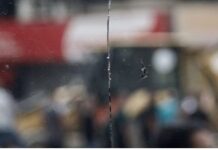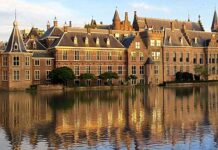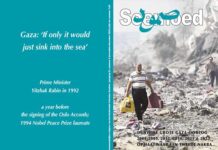Nancy Murray
Mondoweiss / July 23, 2023
James Fergusson’s book takes us through the hydro politics of Israeli domination of Palestinian water resources, from the West Bank, to Gaza, to ’48 Palestine.
IN SEARCH OF THE RIVER JORDAN
A Story of Palestine, Israel and the Struggle for Water
by James Fergusson
293 pp. Yale University Press, New Haven/London (2023), $30.
James Fergusson, a prolific British journalist and author with a master’s degree in hydrogeology, knows how to tell a good story and weave a compelling narrative featuring on-the-ground voices. In Search of the River Jordan, his seventh book, is an investigation of water inequality in Israel-Palestine, written in the style of a frequently enthralling travelogue.
Before he embarks on his travels through the Gaza Strip, the West Bank, Jerusalem, the water-rich Golan Heights (coveted by the Zionists since early in the 20th century) and ’48 Israel that take place sporadically over a three-year period, he is fully aware of the “gross disparity of access to water.” Israelis enjoy an average of 240 liters of fresh water per capita each day, while Palestinians average 72 liters per capita, which in some areas dips to only 25 liters per day (well below the WHO minimum of 50-100 liters required to ensure basic needs are met).
How did this come about? And what, Fergusson wonders, “are the prospects of restoring some semblance of water equality”?
Fergusson declares at the outset, “This book is hardly another liberal polemic against Zionism.” The great-great-great nephew of Arthur Balfour, the British foreign secretary who in 1917 promised Jews a “national home” in Palestine, he is up-front about the connection he has long felt for Israel as he sets out to see for himself exactly why “Palestinians, as well as critics abroad, accuse Israel of ‘weaponizing’ water” while “Israelis deny this.”
What does he find?
He is forced to admit that “in many places, water did indeed appear to have been weaponized” as critics charge. Yes, Israel’s water technology is “genuinely dazzling.” But “Israel’s achievement was founded on many decades of oppression of their neighbors. A people had been cruelly displaced, and their land expropriated, along with their rivers and the groundwater beneath their feet, an accrual of resource that made Israel’s present water surplus possible, and without which the technological water revolution would never have happened.”
Throughout the book, what he refers to as his predisposition to Israel seems considerably deflated. If, as he writes, “Balfour’s hope – his understanding – was that the land, as well as its resources, would be equitably shared in a spirit of mutual neighborly respect,” the facts on the ground show a very different outcome. When Fergusson finally locates the badly vandalized monument to Blanche ‘Baffy’ Dugdale, his Zionist great-grandmother and Balfour’s niece and biographer who Ben-Gurion had compared to the Biblical Deborah, he takes it as “a sign of how badly off-track the Zionist project had strayed” and admits that “modern Israel certainly troubles me.”
And it should trouble those readers of this very informative book who might have been attracted to it by his assurance that it was not a “liberal polemic.”
Gaza: the region’s worst water crisis
His narrative begins with his visit to the Gaza Strip in 2018-2019, which, he writes, feels like a “prison camp” and a “catastrophe in waiting.” He spends a week talking to hydrologists, civic officials, and residents, including women who spend two-thirds of their time seeking access to water when, as during the time he is there, electricity is limited to four hours a day.
His guide, Ahmad Yaqubi, a hydro-engineer who is the retired General Director of the Palestinian Water Authority, takes him to see “an environmental disaster zone” where sewage flows onto beaches because there is no electricity and fuel to keep the wastewater treatment plants operating. He sees how the blockade, Israel’s “dual use” list of banned items, and the need to wait more than six months for chemicals to be permitted entry, prevent even expensive international projects like the new Northern Gaza Emergency Sewage Treatment plant from running smoothly, threatening the health not just of Palestinians, but of Israelis too when Gaza’s untreated sewage flows north.
Before he leaves, he attends one of the Great March of Return demonstrations, which he describes in vivid terms. The Israeli snipers routinely aiming at the knees of young boys terrify him, and he wonders, “how desperate does one have to be to risk death in a futile political protest?”
His description of what Gazans are forced to do to cope with the disastrous shortage of clean water, the malnutrition and disease resulting from the blockade, the destruction to lives, livelihoods, and infrastructure caused by Israel’s frequent bombardments, all add up to a “folly” of a Gaza policy. Apart from the horror, Fergusson is a rare Western journalist who also sees Gaza as “a place brimming with potential.” He alludes to Hamas’ modification of its charter in 2017, and wonders whether it really does want to destroy Israel, the assertion that is constantly made to keep the blockade bolted in place.
The West Bank: weaponized water
The next part of his narrative takes him to the West Bank. Fergusson, who had hoped to walk the length of the 155-mile-long Jordan River, discovers that Israel has made much of it a closed military zone, and the 300,000 mines that it planted after driving out the Jordanian army in 1967 remain largely in place.
Instead of taking a leisurely hike from its (drastically shrinking) Dead Sea end point, he watches American tourists being baptized in a mine-free area of what appears a filthy “ditch” where pilgrims “seemed as likely to ingest E.coli as a dose of heavenly redemption.”
He travels north in the Jordan Valley and describes how the drilling of deep wells by Mekorot (Israel’s National Water Carrier, founded in 1937 and fully online in 1964) destroys Palestinian springs such as Al-Auja, while Palestinians are barred from drilling new wells or repairing old ones, and farmers who can no longer supply water to their flocks are forced off their land.
In the northern Jordan Valley village of Bardala, an ancient community with an unusual post-Oslo Area A status — and hence technically under the administration of the Palestinian Authority — the Mekorot water system servicing Israeli settlers runs right through the town. The Israeli army raids the village from time to time to confiscate hosepipes and other equipment when residents plug into Mekorot’s pipeline. One indication of the breadth of his research is his mention of the Boston-based Alliance for Water Justice in Palestine as an organization that is publicizing Bardala’s water struggles.
Mekorot, he writes, is associated “with Zionism itself, which makes it a water utility with a very special status; one that, in the view of many Israelis, is literally engaged on a holy mission.” Its outsized role in the theft of Palestinian water and the disastrous impact of the Oslo Accords, under which a Joint Water Committee was established in 1995, giving Israel veto power over all Palestinian water decisions, feature throughout Fergusson’s exploration of the water crisis in remote villages near Nablus, Ramallah (headquarters of the hapless and corrupt PA), Bethlehem, Al-Walaja, Battir, Qalqilya, and Bashar al-Masri’s settlement lookalike — the hilltop city of Rawabi.
Israel: water theft builds water prowess
Fergusson devotes the second part of the book to Israel itself and the part that water plays in its mythology, history, and current hydro politics. His tone is simultaneously admiring and jaundiced, in contrast to the unchecked enthusiasm pervading the much-hyped volume by Seth Siegel, Let there be water: Israel’s solution for a water-starved world (2015).
Fergusson hears from Israeli water officials and farmers on how fundamental control of water is to the Zionist mission. He tours facilities that display Israel’s vaunted water innovation — its grey water recycling and “drip irrigation” plants, and the secretive subterranean Sapir pumping station compound on the Galilee. He sees how irrigation — denied to 50 or so ‘unrecognized’ Bedouin villages that Israel is bent on obliterating — has transformed parts of the Negev (Naqab) desert in keeping with Ben-Gurion’s vision. He mentions that one of those villages, Al-Araqeeb, was demolished by the Israeli army for the 209th time by November 2022 (it has now been destroyed at least 218 times).
He also tours Sorek, one of Israel’s five giant coastal desalination plants, which now produces more than 80 percent of its domestic tap water supply. He marvels that Israel now has a substantial water surplus. Why, he asks a water official, does it not make more of it available to Palestinians, “who, since the Oslo Accords, have enjoyed access to only 20 per cent of the water in the West Bank, while Israel controls the rest? What about the unfolding disaster in Gaza?” Why does it even refuse to allow Palestinians to repair their decaying water network without Israeli permission?
These are questions without satisfactory answers from Fergusson’s Israeli guides. They trouble the staff of the Arava Institute for Environmental Studies, which was set up post-Oslo to showcase how cooperation on water and environmental matters like the now-stalled Red-to-Dead Seawater Conveyance Project could, in the words of its associate director Shira Kronich, “feed into a two-state solution.”
Fergusson, too, sees water as the lubricant for a two-state future. He declares that
“Israel, in the end, faces a choice. It can either continue to pursue its policy of dominance over the Palestinians, with all the misery it causes, and all the domestic insecurity it brings; or it can start to frame its future in terms of a genuine partnership: in other words, to get serious about the two-state solution. And a new settlement in the water sector might be an excellent place to begin.”
Given everything he has seen on the ground, Fergusson’s advocacy of a two-state future in which water is equitably shared seems decades too late, and more an homage to his idealized, politics-free view of what the Balfour Declaration was about than a practical course of action to pursue under current conditions.
But that does not detract from the importance of his book, which has the potential to attract and educate a general audience about what Zionism has meant to Palestinians, and the impact of Israel’s apartheid practices. Although he does not personally embrace the word “apartheid,” it is mentioned many times in the interviews he conducts.
He ends with this warning:
“Palestine’s water crisis is not going away, but deepening. Nature has her own way of talking, and will not wait. Technology can achieve wonders; but those wonders may not last long if they are not underpinned by a rights-based settlement, including restitution to the Palestinians of the most important right of all, the human right to water.”
Given the grossly skewed power dynamics, he places the ball firmly in Israel’s court.
Nancy Murray is a member of the Alliance for Water Justice in Palestine












